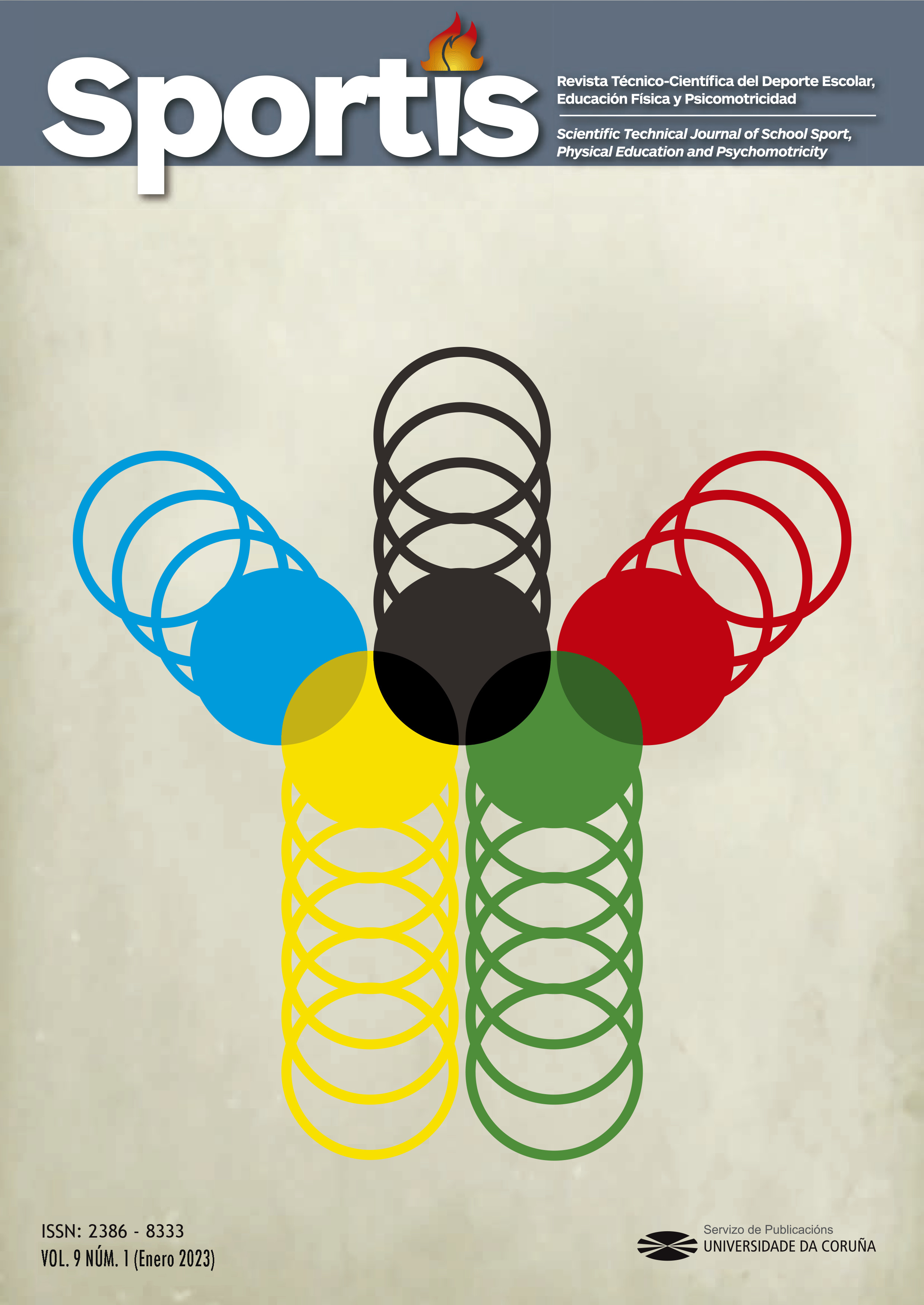Sondeo fenomenológico sobre las experiencias de los maestros de secundaria superior en la enseñanza de deportes de atletismo durante los años de transición de Filipinas K a 12
Contenido principal del artículo
Resumen
El sistema educativo filipino se encuentra actualmente en transición debido a la implementación de la Ley de la República 10533, también conocida como Ley de Educación Básica Mejorada. Desde su promulgación en 2013, los investigadores de educación física han estado examinando el impacto inicial de esta transición. Sin embargo, las investigaciones para determinar los desafíos de los profesores en el Programa de Pista deportiva del plan de estudios de la escuela secundaria superior fueron escasamente suficientes. Por lo tanto, esta investigación se llevó a cabo para sondear los desafíos de estos profesores utilizando un diseño de investigación de fenomenología cualitativa. Los participantes de la investigación de escuelas seleccionadas en la provincia de Cotabato en Filipinas participaron en discusiones de grupos focales, entrevistas en profundidad y una extensa observación de campo. Transcurrieron seis preocupaciones significativas de los participantes de la investigación; estos son: dificultades con el aprendizaje en línea; desajuste de los intereses de los estudiantes; plan de estudios poco realista; instalaciones inadecuadas; cargas de enseñanza sobrecargadas; y luchas de los no graduados en educación física. Luego, los hallazgos sirvieron como elementos cruciales para sacar conclusiones y recomendaciones para implementar mejor el programa de atletismo deportivo en el plan de estudios de la escuela secundaria superior de Filipinas.
Palabras clave:
Descargas
Detalles del artículo
Citas
Agboola, B. M., Adeyemi, J., & Ogbodo, C. M. (2014). Academic Achievement and Admission Policy as Correlate of Student Retention in Nigerian Federal Universities. International Journal of Business and Social Sciences, 5(2), 101-108.
Akosah-Twumasi, P., Emeto, T. I., Lindsay, D., Tsey, K., & Malau-Aduli, B. S. (2018, July). A systematic review of factors that influence youths career choices—the role of culture. In Frontiers in Education (Vol. 3, p. 58). Frontiers Media SA. https://doi.org/10.3389/feduc.2018.00058
Aldevera, A. D., Alenton, L. B., & Gantuangco, P. R. (2019). Lived Experiences of the Senior High School Teachers. Padayon Sining: A celebration of the enduring value of the humanities.
Ancheta, R. (2020). The New Normal Education: A Challenge to the Private Basic Education Institutions in the Philippines? International Journal of Educational Management and Development Studies, 6-11. https://doi.org/10.53378/345960
Baykara, Z., & Orhan, R. (2020). An analysis of job satisfaction levels of physical education teachers in Ankara, Turkey. Educational Research and Reviews, 65-71.
Bernas, J. G. (1996). The 1987 constitution of the Republic of the Philippines: A commentary. Rex Bookstore, Inc.
Brilliantes, K. B., Orbeta , A. J., Francisco-Abrigo, K. A., Capones, E. M., & Jovellanos, J. B. (2019). Status of Senior High School Implementation: A Process Evaluation. Philippine Institute for Developmental Studies.
Cinkir, S., & Kurum, G. (2015). Discrepancy in Teacher Employment: The Problem of Out-Of-Field Teacher Employment. Educational Planning, 22(1), 43.
Cogal, M. N., Diestro, C. D., Nacorda, S. H., & Paras, M. C. (2019). Effective Implementation of the Senior High School Curriculum: A Descriptive Analysis. International Journal of Engineering Research and Technology, 8(12).
Development Asia. (2019, August 7). Factors Affecting Senior High School Track Offerings in the Philippines. Retrieved from Development Asia: https://development.asia/insight/factors-affecting-senior-high-school-track-offerings-philippines
Eddles-Hirsch, K. (2015). Phenomenology and educational research. International Journal of Advanced Research, 3(8).
Edrmann, A. & Marin, A. (2019). Can we improve academic performance and student satisfaction without additional time cost for teachers? Evidence from a blended methodology in Microeconomics. Multidisciplinary Journal for Education, Social and Technological Sciences, 6(2), 54-91. https://doi.org/10.4995/muse.2019.11869
Garcia, E., & Weiss, E. (2019). The teacher shortage is real, large and growing, and worse than we thought. Washington: Economy Policy Institute. https://www.epi.org/publication/the-teacher-shortage-is-real-large-and-growing-and-worse-than-we-thought-the-first-report-in- the-perfect-storm-in-the-teacher-labor-market-series/
Jeong, H.-C., & So, W.-Y. (2020, October 5). Difficulties of Online Physical Education Classes in Middle and High School and an Efficient Operation Plan to Address Them. International Journal of Environmental Research and Public Health, 1-12. https://polipapers.upv.es/index.php/MUSE/article/view/11869
Maloney, K. (2020). The Effects of Class Size on Student Achievement. Culminating Projects in Teacher Development, 23. https://repository.stcloudstate.edu/cgi/viewcontent.cgi?article=1053&context=ed_e Ltd
Mercier, K., Centeio, E., Garn, A., Erwin, H., Marttinen, R., & Foley, J. (2021). Physical Education Teachers' Experiences With Remote Instruction During the Initial Phase of the Covid-19 Pandemic. Journal of Teaching in Physical Education, 337-342. https://doi.org/10.1123/jtpe.2020-0272
Nucum, K. (2018, October 8). SHS Sports Track: What is it all about? Edukasyon.ph: https://www.edukasyon.ph/blog/shs-sports-track-what-is-it-all-about
Piantanida, M., & Garman, N. B. (Eds.). (2009). The qualitative dissertation: A guide for students and faculty. Corwin Press.
Richards, K. R., Washburn, N., Carson, R. L., & Hemphill, M. A. (2017). A 30-year scoping review of the physical education teacher satisfaction literature. Quest, 495-514. https://doi.org/10.1080/00336297.2017.1296365
Rutkowska, K., & Zalech, M. (2015). Job Satisfaction of a Physical Education Teacher as Seen by School Community. Physical Culture and Sport, Studies and Research, 34-40.
Sanni, D. M., Ede, C., & Fashina, A. A. (2018). A study on the effects of inadequate sport equipment and facilities on sports development and academic performance in primary schools: a case study of Bwari area council of Abuja-Nigeria. SPC Journal of Education. http://dx.doi.org/10.14419/je.v1i1.13946
Sergio, M. R. S. (2012). K-12 education reform: Problems and prospects. Ateneo de Naga University Gibon, 9, 70-80.
Trance, N. C., & Trance, L. L. (2019). Embracing the K-12 curriculum: Accounts of Philippine Teachers and Students. Journal of Physics: Conference Series, 1-9. https://doi.org/10.1088/1742-6596/1254/1/0120311
Torres Navarro, V. (2018). Influence of sports satisfaction and interest on a physical fitness program of students in ESO. Sportis. Scientific Technical Journal of School Sport, Physical Education and Psychomotricity, 4(1), 16-36. https://doi.org/10.17979/sportis.2018.4.1.2089
Varea, V., Gonzales-Calvo, G., & Garcia-Monge, A. (2020). Exploring the Changes of Physical Education in the Age of Covid-19. Physical Education and Sport Pedagogy. https://doi.org/10.1080/17408989.2020.1861233
Yıldızer, G., Ektirici, A., Eren, G., Özböke, C., & Yılmaz, İlker. (2018). Views of first time implementers physical education and sports teachers on health related fitness report card. Sportis. Scientific Technical Journal of School Sport, Physical Education and Psychomotricity, 4(3), 538-556. https://doi.org/10.17979/sportis.2018.4.3.3401






